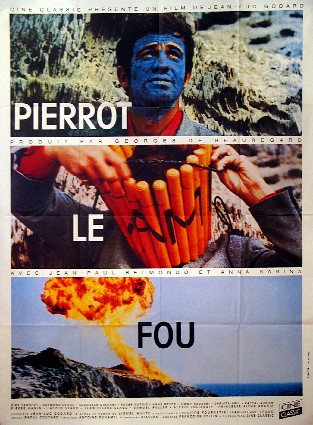
Pierrot Le Fou, yet another one of Jean-Luc Godard's French New Wave triumphs, is nothing if not a fantastic ode to life and living. This stylish and spontaneous creation by Godard makes for one of the most enjoyable film experiences one could ever imagine. From a filmmaking standpoint, its risky and extemporaneous style does not owe itself to firm calculation or narrative logic; rather, its the ecstatic enthusiasm that Godard conveys through Jean-Pierre Belmondo and Anna Karina that heightens this film. In the first several minutes of the film, we are introduced to Belmondo's character Ferdinand who reads to his daughter in a bathtub the words of the painter Diego Velasquez. Godard excites the senses with visions akin to Belmondo's words. However, in an instant he is interrupted by his wife, whose sudden request for Ferdinand to dress up for a classy adult party comes as no surprise in light of her flashy bourgeois lifestyle.
At the party, Ferdinand is surrounded by "imbeciles", as he puts it, which include the American film director Sam Fuller, who describes the cinema as a battleground of emotions. These uncomfortable diversions lead Ferdinand to leave the party and take off excitedly with the babysitter at his house, Marianne Renior (Anna Karina). From here on out we are in a world of the hyperreal, where Marianne and Ferdinand's actions are venturesome and romanticized. Supporting the "opposites attract" concept, Belmondo plays an apostle of cool and contemplative whereas Marianne is an antsy free-spirit. Her unusual connections with Algerian gangsters continually divert her attention and thus ruin Ferdinand's mad hopes of a simple existence by the Mediterranean Sea, quietly working on his writing and enjoying Marianne's company. Essentially, she destroys him personally, spiritually, and artistically. However, their relationship is so lucid and radiant that he can't abandon her.
They are on an idealized tirade of the French countryside, doing whatever they feel like with no regard to the repercussions, and this is precisely what Godard is doing in a filmic sense. If ever a filmmaker is splashing buckets of paint onto a blank canvas, this is that film. Godard's relentless visual and conceptual ideas are marvelously entertaining, telling the tale with outbursts of emotion in short and often times unconnected sequences. The film is like a memory or a dream, and this notion is further supported by Ferdinand and Marianne's unpunished ruthlessness. Not to mention we get that sense of colors being ultra-saturated to the point of blinding vibrancy with the help of Criterion's dazzling transfer. Raoul Coutard, the cinematographer, uses red and sky blue with such remarkable coherence. I am tempted to say that it's one of the most magnificent uses of color I've ever seen in a film. The imagery of the peaceful abodes by the Mediterranean is ravishing and transcendent, clearly representing the lavish side of life in contrast with the "gangster film" that Karina speaks of in voice-over. Pierrot Le Fou, because of its ecstatic vision and Belmondo and Karina's great chemistry, cannot be missed.

No comments:
Post a Comment